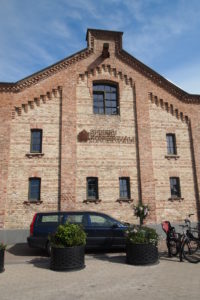Spīķeri in Riga started its fourth life as a vibrant cultural area.
website New Europe – Cities in transition
Recently the Spīķeri Quarter in Riga underwent a metamorphosis. The old port area has transformed from a crumbled no go area to a cultural hotspot. Art galleries, media centres, a concert hall, cafes, organic food restaurants and eco stores settled now in renovated warehouses. There are outdoor concerts, poetry slams and street festivals. Spikeri offers place to a flea market, skating and dance contests and more. ‘We are still looking for the best programming,’ says Elina Pundure, communications officer of the Spikeru foundation that manages and runs Spīķeri since a year. ‘Where does the city need, what do the people want?’ Now the emphasis is on cultural and social media activities.
The Spīķeri Quarter lies along the river Daugava. In the 19th century, the warehouses stored goods to and from Hanseatic City of Riga. Later they offered housing to garrisons of the Russian tsar, the autonomous Latvian State, the Nazis and the Soviets and they served as storage of military equipment. After Latvia regained independence in 1991, the warehouses were neglected for a long time. The redevelopment of the area began in 2007. The warehouses are renovated and owned by real estate companies, Riga municipality is responsible for the redesign of public space. About half of the public funding came from European funds.
Now Spīķeri started its fourth life as a cultural hotspot, on the edge of the Centre of the city in Maskavas Forstate, Moscow suburb). It is located at the Maskavas iela (road towards Moscow). Before the Second World War, primarily Russian and Jewish families lived in this area. The Nazis drove the non-Jewish Russians out of their homes and turned it into a Jewish ghetto. In 1941 between 28.000 and 29.000 Jews were deported along this road to the wood of Rumbula, eight kilometre from Riga. Spīķeri commemorates this tragic history in a small Holocaust museum in one of the last warehouses on site.

